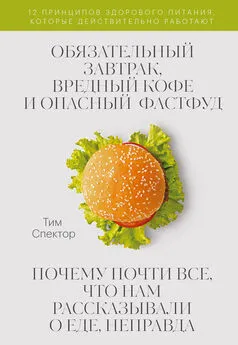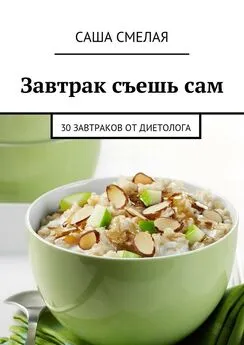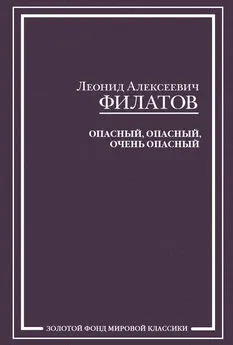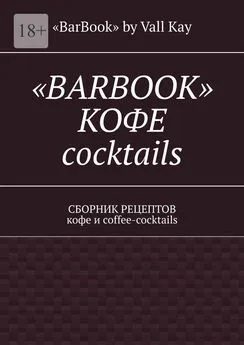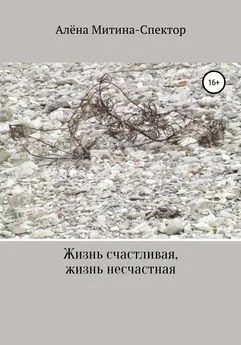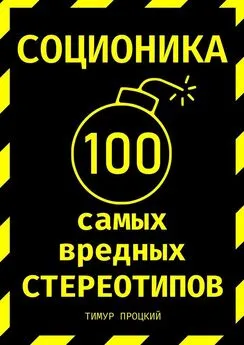Тим Спектор - Обязательный завтрак, вредный кофе и опасный фастфуд
- Название:Обязательный завтрак, вредный кофе и опасный фастфуд
- Автор:
- Жанр:
- Издательство:Манн, Иванов и Фербер
- Год:2021
- Город:Москва
- ISBN:9785001697381
- Рейтинг:
- Избранное:Добавить в избранное
-
Отзывы:
-
Ваша оценка:
Тим Спектор - Обязательный завтрак, вредный кофе и опасный фастфуд краткое содержание
Тим Спектор провел беспрецедентное исследование, в результате которого понял, насколько необоснованны большинство глубоко укорененных в нашем сознании представлений о еде. В каждой главе своей книги он объясняет, почему почти всё, что нам рассказывали о еде, неправда.
Прочитав его книгу, вы сможете полностью переосмыслить свое отношение к еде и научитесь формировать собственный индивидуальный рацион на основе научных рекомендаций.
Обязательный завтрак, вредный кофе и опасный фастфуд - читать онлайн бесплатно ознакомительный отрывок
Интервал:
Закладка:
117
Anderson J. J. Red and processed meat consumption and breast cancer: UK Biobank cohort study and meta-analysis // Eur. J. Cancer. 2018. Vol. 90. Pp. 73–82.
118
Średnicka-Tober D. Composition differences between organic and conventional meat: a systematic literature review and meta-analysis // Br. J. Nutr. 2016. Vol. 115. No. 6. Pp. 994–1011.
119
Willett W. Food in the Anthropocene: the EAT-Lancet commission on healthy diets from sustainable food systems // The Lancet. 2019. Vol. 393. Pp. 447–492.
120
Poore J. Reducing food’s environmental impacts through producers and consumers // Science. 2018. Vol. 360. No. 6392. Pp. 987–992.
121
Springmann M. Options for keeping the food system within environmental limits // Nature. 2018. Vol. 562. Pp. 519–525.
122
Springmann M. Health-motivated taxes on red and processed meat: a modelling study on optimal tax levels and associated health impacts // PLOS ONE. 2018. Vol. 13. No. 11. P. e0204139.
123
Capper J. L. The environmental impact of beef production in the United States: 1977 compared with 2007 // Journal of Animal Science. 2011. Vol. 89. Pp. 4249–4261.
124
Lopez A. Iron deficiency anemia // The Lancet. 2016. Vol. 387. No. 10021. Pp. 907–916.
125
Mentre A. Evolving evidence about diet and health // The Lancet Public Health. 2018. Vol. 3. No. 9. Pp. e408–e409; Jacka F. N. Association of Western and traditional diets with depression and anxiety in women // American Journal of Psychiatry. 2010. Vol. 167. No. 3. Pp. 305–311.
126
Jacka F. N. Red meat consumption and mood and anxiety disorders // Psychotherapy and Psychosomatics. 2012. Vol. 81. No. 3. Pp. 196–198.
127
Daley C. A. A review of fatty acid profiles and antioxidant content in grass-fed and grain-fed beef // Nutrition Journal. 2010. Vol. 9. No. 1. P. 10.
128
Pelucchi C. Dietary acrylamide and cancer risk: an updated meta-analysis // International Journal of Cancer. 2015. Vol. 136. Pp. 2912–2922.
129
Lee J. G. Effects of grilling procedures on levels of polycyclic aromatic hydrocarbons in grilled meats // Food Chemistry. 2016. Vol. 199. Pp. 632–638; Stec A. A. Occupational exposure to polycyclic aromatic hydrocarbons and elevated cancer incidence in firefighters // Scientific Reports. 2018. Vol. 8. No. 1. P. 2476.
130
Скампи (итал. scampi) — крупная морская креветка с длинными тонкими клешнями; другие названия: норвежский омар, дублинская креветка, лангустин. В итальянской кухне таких креветок поджаривают на гриле: шейки маринуют в оливковом масле с чесноком и жарят на шампурах; также иногда их употребляют в сыром виде (scampi crudi).
131
Gifford C. L. Broad and inconsistent muscle food classification is problematic for dietary guidance in the US // Nutrients. 2017. Vol. 9. No. 9. P. 1027.
132
Bergeron N. Effects of red meat, white meat, and nonmeat protein sources on atherogenic lipoprotein measures in the context of low compared with high saturated fat intake: a randomized controlled trial // Am. J. Clin. Nutr. 2019. Jun. 4: online.
133
EFSA. Opinion of the scientific panel on food additives, flavorings, processing aids and materials in contact with food (AFC) related to treatment of poultry carcasses with chlorine dioxide, acidified sodium chlorite, trisodium phosphate and peroxyacids // European Food Safety Authority. 2006. Vol. 4. No. 1. P. 297.
134
Harvey F. British supermarket chickens show record levels of antibioticresistant superbugs // The Guardian. 2018. January 15.
135
Lawrence F. Revealed: the dirty secret of the UK’s poultry industry // The Guardian. 2014. July 23.
136
Преимущественно растительная диета с небольшой долей продуктов животного происхождения в рационе.
137
Raji C. A. Regular fish consumption and age-related brain gray matter loss // American Journal of Preventive Medicine. 2014. Vol. 47. No. 4. Pp. 444–451.
138
Morris M. C. Fish consumption and cognitive decline with age in a large community study // Archives of Neurology. 2005. Vol. 62. No. 12. Pp. 1849–1853.
139
Короткоцепочечными принято считать кислоты с длиной цепи меньше 6 атомов углерода, поэтому альфа-линоленовая кислота не является короткоцепочечной (в ней 18 атомов углерода). В ЭПК 20 атомов углерода, в ДГК 21 атом углерода. Прим. науч. ред.
140
Saunders A. V. Omega-3 polyunsaturated fatty acids and vegetarian diets // Medical Journal of Australia. 2013. Vol. 1. No. 2. Pp. 22–26.
141
Stonehouse W. Does consumption of LC omega-3 PUFA enhance cognitive performance in healthy school-aged children and throughout adulthood? Evidence from clinical trials // Nutrients. 2014. Vol. 6. No. 7. Pp. 2730–2758; Cooper R. E. Omega-3 polyunsaturated fatty acid supplementation and cognition: a systematic review & metaanalysis // Journal of Psychopharmacology. 2015. Vol. 29. No. 7. Pp. 753–763.
142
Øyen J. Fatty fish intake and cognitive function: FINS-KIDS, a randomized controlled trial in preschool children // BMC Medicine. 2018. Vol. 16. P. 41.
143
Gould J. F. Seven-year follow-up of children born to women in a randomized trial of prenatal DHA supplementation // JAMA. 2017. Vol. 317. No. 11. Pp. 1173–1175.
144
Engeset D. Fish consumption and mortality in the European Prospective Investigation into Cancer and Nutrition cohort // European Journal of Epidemiology. 2015. Vol. 30. No. 1. Pp. 57–70.
145
Schwingshackl L. Food groups and risk of all-cause mortality: a systematic review and meta-analysis // American Journal of Clinical Nutrition. 2017. Vol. 105. No. 6. Pp. 1462–1473.
146
Song M. Association of animal and plant protein intake with all-cause and causespecific mortality // JAMA Internal Medicine. 2016. Vol. 176. No. 10. Pp. 1453–1463.
147
Siscovick D. S. Omega-3 polyunsaturated fatty acid (fish oil) supplementation and the prevention of clinical cardiovascular disease: a science advisory from the American Heart Association // Circulation. 2017. Vol. 135. No. 15. Pp. e867–e884.
148
Aung T. Associations of omega-3 fatty acid supplement use with CVD risks: metaanalysis of 10 trials involving 77,917 individuals // JAMA Cardiology. 2018. Vol. 3. No. 3. Pp. 225–234.
149
Abdelhamid A. S. Omega-3 fatty acids for the primary and secondary prevention of cardiovascular disease // Cochrane Systematic Review. 2018. Vol. 7. P. CD003177.
150
Manson J. E. Marine n–3 fatty acids and prevention of cardiovascular disease and cancer // New England Journal of Medicine. 2019. Vol. 380. Pp. 23–32.
151
Senftleber N. K. Marine oil supplements for arthritis pain: a systematic review and meta-analysis of randomized trials // Nutrients. 2017. Vol. 9. No. 1. P. e42.
152
Астаксантин — природный пигмент, придающий различным видам рыб, морских животных, водорослям и перьям птиц красную окраску. В организме человека выполняет функцию антиоксиданта, способствует поддержанию остроты зрения. Прим. науч. ред.
153
Tacon A. G. Global overview on the use of fish meal and fish oil in industrially compounded aquafeeds // Aquaculture. 2008. Vol. 285. No. 1–4. Pp. 146–158.
154
Poore J. Reducing food’s environmental impacts through producers and consumers // Science. 2018. Vol. 360. No. 6392. Pp. 987–992.
155
Han Y. Fishmeal application induces antibiotic resistance gene propagation in mariculture sediment // Environmental Science and Technology. 2017. Vol. 51. No. 18. Pp. 10850–10860.
156
Whittle P. Plagues of parasitic sea lice depleting world’s salmon stocks // The Independent. 19 September 2017.
157
Khan S. Scottish salmon sold by a range of supermarkets in the UK has sea lice up to 20 times the acceptable amount // The Independent. 29 October 2017.
158
Christensen J. Fish fraud: what’s on the menu often isn’t what’s on your plate // CNN. March 7, 2019.
159
Warner K. Deceptive dishes: seafood swaps found worldwide // Oceana Report. 7 September 2016.
160
Willette D. A. Using DNA barcoding to track seafood mislabeling in Los Angeles restaurants // Conservation Biology. 2017. Vol. 31. No. 5. Pp. 1076–1085.
161
Gander K. Fraudsters are dyeing cheap tuna pink and selling it on as fresh fish in £174m industry // The Independent. 18 January 2017.
162
Kuchta R. Diphyllobothrium nihonkaiense tapeworm larvae in salmon from North America // Emerging Infectious Diseases. 2017. Vol. 23. No. 2. Pp. 351–353.
163
Iwata K. Is the quality of sushi ruined by freezing raw fish and squid? A randomized double-blind trial // Clinical Infectious Diseases. 2015. Vol. 60. No. 9. Pp. e43–e48.
164
Planchart A. Heavy metal exposure and metabolic syndrome: evidence from human and model system studies // Current Environmental Health Reports. 2018. Vol. 5. No. 1. Pp. 110–124.
165
Oken E. Fish consumption, methylmercury and child neurodevelopment // Current Opinion in Pediatrics. 2008. Vol. 20. No. 2. Pp. 178–183; Sagiv S. K. Prenatal exposure to mercury and fish consumption during pregnancy and attention-deficit/hyperactivity disorder-related behavior in children // Archives of Pediatrics and Adolescent Medicine. 2012. Vol. 166. No. 12. Pp. 1123–1131.
166
Galloway T. S. Marine microplastics spell big problems for future generations // Proceedings of the National Academy of Sciences. 2016. Vol. 113. No. 9. Pp. 2331–2333.
167
Abdelhamid A. S. Omega-3 fatty acids for the primary and secondary prevention of cardiovascular disease // Cochrane Systematic Review. 2018. Vol. 7. P. CD003177.
168
Интервал:
Закладка:
